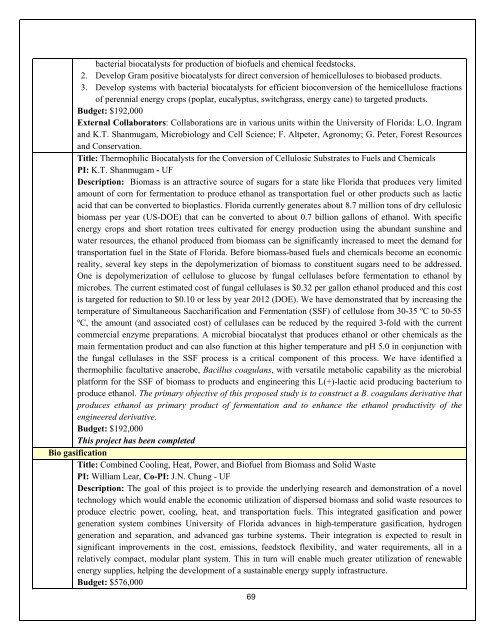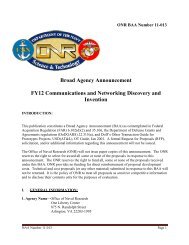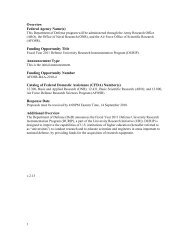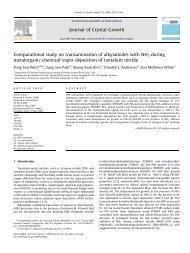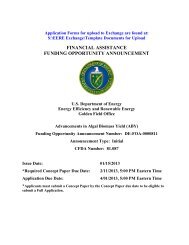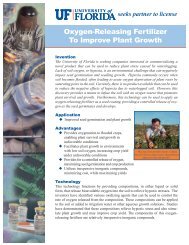Annual Report- Part III - Florida Energy Systems Consortium
Annual Report- Part III - Florida Energy Systems Consortium
Annual Report- Part III - Florida Energy Systems Consortium
You also want an ePaper? Increase the reach of your titles
YUMPU automatically turns print PDFs into web optimized ePapers that Google loves.
acterial biocatalysts for production of biofuels and chemical feedstocks.2. Develop Gram positive biocatalysts for direct conversion of hemicelluloses to biobased products.3. Develop systems with bacterial biocatalysts for efficient bioconversion of the hemicellulose fractionsof perennial energy crops (poplar, eucalyptus, switchgrass, energy cane) to targeted products.Budget: $192,000External Collaborators: Collaborations are in various units within the University of <strong>Florida</strong>: L.O. Ingramand K.T. Shanmugam, Microbiology and Cell Science; F. Altpeter, Agronomy; G. Peter, Forest Resourcesand Conservation.Title: Thermophilic Biocatalysts for the Conversion of Cellulosic Substrates to Fuels and ChemicalsPI: K.T. Shanmugam - UFDescription: Biomass is an attractive source of sugars for a state like <strong>Florida</strong> that produces very limitedamount of corn for fermentation to produce ethanol as transportation fuel or other products such as lacticacid that can be converted to bioplastics. <strong>Florida</strong> currently generates about 8.7 million tons of dry cellulosicbiomass per year (US-DOE) that can be converted to about 0.7 billion gallons of ethanol. With specificenergy crops and short rotation trees cultivated for energy production using the abundant sunshine andwater resources, the ethanol produced from biomass can be significantly increased to meet the demand fortransportation fuel in the State of <strong>Florida</strong>. Before biomass-based fuels and chemicals become an economicreality, several key steps in the depolymerization of biomass to constituent sugars need to be addressed.One is depolymerization of cellulose to glucose by fungal cellulases before fermentation to ethanol bymicrobes. The current estimated cost of fungal cellulases is $0.32 per gallon ethanol produced and this costis targeted for reduction to $0.10 or less by year 2012 (DOE). We have demonstrated that by increasing thetemperature of Simultaneous Saccharification and Fermentation (SSF) of cellulose from 30-35 ºC to 50-55ºC, the amount (and associated cost) of cellulases can be reduced by the required 3-fold with the currentcommercial enzyme preparations. A microbial biocatalyst that produces ethanol or other chemicals as themain fermentation product and can also function at this higher temperature and pH 5.0 in conjunction withthe fungal cellulases in the SSF process is a critical component of this process. We have identified athermophilic facultative anaerobe, Bacillus coagulans, with versatile metabolic capability as the microbialplatform for the SSF of biomass to products and engineering this L(+)-lactic acid producing bacterium toproduce ethanol. The primary objective of this proposed study is to construct a B. coagulans derivative thatproduces ethanol as primary product of fermentation and to enhance the ethanol productivity of theengineered derivative.Budget: $192,000This project has been completedBio gasificationTitle: Combined Cooling, Heat, Power, and Biofuel from Biomass and Solid WastePI: William Lear, Co-PI: J.N. Chung - UFDescription: The goal of this project is to provide the underlying research and demonstration of a noveltechnology which would enable the economic utilization of dispersed biomass and solid waste resources toproduce electric power, cooling, heat, and transportation fuels. This integrated gasification and powergeneration system combines University of <strong>Florida</strong> advances in high-temperature gasification, hydrogengeneration and separation, and advanced gas turbine systems. Their integration is expected to result insignificant improvements in the cost, emissions, feedstock flexibility, and water requirements, all in arelatively compact, modular plant system. This in turn will enable much greater utilization of renewableenergy supplies, helping the development of a sustainable energy supply infrastructure.Budget: $576,00069


